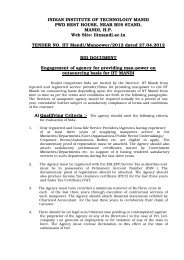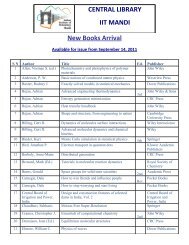Eco Report of the area - IIT Mandi
Eco Report of the area - IIT Mandi
Eco Report of the area - IIT Mandi
You also want an ePaper? Increase the reach of your titles
YUMPU automatically turns print PDFs into web optimized ePapers that Google loves.
The suggested lay out will also enable securing <strong>the</strong> boundary <strong>of</strong> <strong>the</strong> Campus against unwarranted<br />
human intrusion. The perimeter <strong>of</strong> <strong>the</strong> Campus is quite long due to its shape and orientation.<br />
Fur<strong>the</strong>r, <strong>the</strong> topography, <strong>the</strong> presence <strong>of</strong> <strong>the</strong> nallah and at least one highway (Katuala-<strong>Mandi</strong> road)<br />
do not permit construction <strong>of</strong> a wall all around <strong>the</strong> Campus. The boundaries <strong>of</strong> <strong>the</strong> Campus can at<br />
best be marked and secured with a fence.<br />
The suggested lay out does permit securing <strong>the</strong> buildings and o<strong>the</strong>r infrastructure blockwise. Major<br />
blocks proposed are Gharpa (Administration, Guest House, etc), Hilog (Lecture Halls, etc) and<br />
Salgi-Chargha-Mayal (Utilities, Residential). Whereas each block can have a gate, <strong>IIT</strong> <strong>Mandi</strong> as<br />
such cannot function from within a walled or insulated Campus.<br />
Thoroughfare through <strong>the</strong> Campus cannot be entirely stopped as <strong>the</strong> Kataula-<strong>Mandi</strong> road runs<br />
across. While this road is outside <strong>the</strong> boundary in most parts <strong>of</strong> <strong>the</strong> Campus, it cuts through <strong>the</strong><br />
<strong>area</strong>s between Salgi (north) and Mayal and between Hilog and Gharpa. The dirt road opposite <strong>the</strong><br />
proposed Communication Center that runs through Salgi-Charga (east) and <strong>the</strong> metal-capped road<br />
from Kamandh to Navalai (through Hilog) are within <strong>the</strong> boundaries <strong>of</strong> <strong>the</strong> Campus. These roads<br />
are important links to some <strong>of</strong> <strong>the</strong> villages around <strong>the</strong> Campus.<br />
Checkposts at strategic points can regulate unwarranted human intrusions. The existing roads can<br />
serve as <strong>the</strong> arterial roads. Newer roads can be minimized, restricting <strong>the</strong>m to stairways along <strong>the</strong><br />
slopes, foot overbridges across <strong>the</strong> nallah and if necessary cable cars (for emergencies and<br />
restricted use) to <strong>the</strong> guest houses.<br />
The most critical habitat within <strong>the</strong> Campus is <strong>the</strong> nallah and <strong>the</strong> riparian vegetation that sustains it.<br />
The riparian vegetation overhangs <strong>the</strong> nallah (also in some parts <strong>the</strong> river Uhl) and is habitat to a<br />
range <strong>of</strong> native herbs, shrubs, palms, grasses and ferns. Native species such as <strong>the</strong> Ivy (Hedera<br />
helix), climbing fig (Ficus foveolata), wild pepper (Piper brachystachyum) and <strong>the</strong> aroid Scindaspus<br />
<strong>of</strong>ficinalis are species that not only have attractive evergreen foliage but also roots and stems that<br />
bind soil and rocks toge<strong>the</strong>r. This vegetation plays a very crucial role in preventing soil erosion and<br />
protecting <strong>the</strong> gorges against landslides.<br />
The scrub on <strong>the</strong> slopes is critical too. This vegetation is comprised <strong>of</strong> native plants that provide <strong>the</strong><br />
spring and autumn colors to <strong>the</strong> landscape. The rich diversity <strong>of</strong> birds on <strong>the</strong> Campus may be<br />
attributed to this vegetation. Broadleaved deciduous vegetation is found along <strong>the</strong> slopes in parts<br />
<strong>of</strong> Salgi bordering Chargha. This type <strong>of</strong> vegetation is <strong>the</strong> most extensive in Chargha. The<br />
7
















